Related Research Articles

Tân Sơn Nhất International Airport is an international airport serving Ho Chi Minh City, the most populous city in Vietnam. The airport is located in the Tân Bình district within the Ho Chi Minh City metropolitan area.
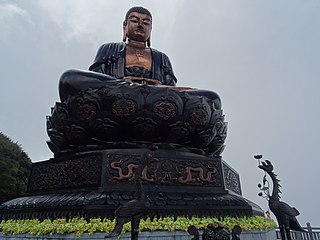
Buddhism in Vietnam, as practiced by the Vietnamese people, is a form of East Asian Mahayana Buddhism. It is the main religion in Vietnam. Vietnamese Buddhism is generally inclusive and syncretic, drawing on the main Chinese Buddhist traditions, such as Tiantai and Huayan, Zen (Thiền), and Pure Land.

The Trần dynasty,, officially Đại Việt, was a Vietnamese dynasty that ruled from 1225 to 1400. The dynasty was founded when emperor Trần Thái Tông ascended to the throne after his uncle Trần Thủ Độ orchestrated the overthrow of the Lý dynasty. The Trần dynasty defeated three Mongol invasions, most notably during the decisive Battle of Bạch Đằng River in 1288. The final emperor of the dynasty was Thiếu Đế, who was forced to abdicate the throne in 1400, at the age of five years old in favor of his maternal grandfather, Hồ Quý Ly.

The Lê dynasty, also known in historiography as the Later Lê dynasty, officially Đại Việt, was the longest-ruling Vietnamese dynasty, having ruled from 1428 to 1789, with an interregnum between 1527 and 1533. The Lê dynasty is divided into two historical periods: the Initial Lê dynasty before the usurpation by the Mạc dynasty, in which emperors ruled in their own right, and the Revival Lê dynasty, in which emperors were figures reigned under the auspices of the powerful Trịnh family. The Revival Lê dynasty was marked by two lengthy civil wars: the Lê–Mạc War (1533–1592) in which two dynasties battled for legitimacy in northern Vietnam and the Trịnh–Nguyễn Wars between the Trịnh lords in North and the Nguyễn lords of the South.

Đặng Hữu Phúc is a Vietnamese pianist and composer best known for his film scores. A graduate of the Hanoi Conservatory, he has penned over 60 works, primarily for film and theatre.
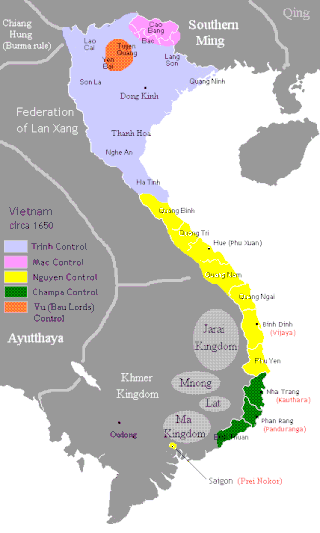
The Nguyễn lords, also known as the Nguyễn clan, were a feudal nobility clan that ruled southern part of Đại Việt during the Revival Lê dynasty and ancestors of Nguyễn dynasty's emperors. The territory they ruled was known contemporarily as Đàng Trong and known by Europeans as Kingdom of Cochinchina and by Imperial China as Kingdom of Quảng Nam, in opposition to the Trịnh lords ruling northern Đại Việt as Đàng Ngoài, known as Kingdom of Tonkin by Europeans and Kingdom of Annam by Imperial China in bilateral diplomacy. They were officially called King of Nguyễn in 1744 when lord Nguyễn Phúc Khoát self-proclaimed himself to elevate his status equally to Trịnh lords's title known as King of Trịnh . Both Nguyễn and Trịnh clans were de jure subordinates and fief of the Lê dynasty. However, The de jure submission of the Nguyễn lords to the Trịnh lords ended in 1600.

Princess Huyền Trân (1289-1340) was a princess of the Trần Dynasty of Đại Việt, who later married to King Jaya Simhavarman III of Champa and titled queen consort Parameshvari of Champa from 1306 to 1307.
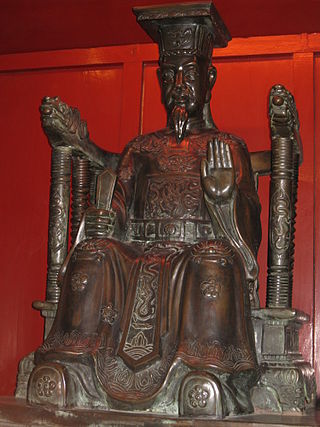
Lý Thánh Tông, personal name Lý Nhật Tôn, temple name Thánh Tông, was the third emperor of the Lý dynasty and the 8th ruler of the Vietnamese kingdom Đại Việt. In his reign, Lý Thánh Tông promoted the agricultural development, reducing some harsh laws and building many Confucianist and Buddhist institutions, most notably the first Temple of Literature in Vietnam (1072). He also fought several successful wars with Champa, resulting in the expansion of Vietnamese territory to the areas which are Quảng Bình Province and Quảng Trị Province today. Chinese sources identify Lý Nhật Tôn as the Viet monarch that dared to claim imperial status, which for the Chinese was a direct challenge to their view of the world that prelude to the Song-Viet war in 1070s.

Vân Đồn is a rural district of Quảng Ninh province in the Northeast region of Vietnam. As of 2003 the district had a population of 39,157. The district covers an area of 551 km². The district capital lies at Cái Rồng. The district is selected as a Special Economic Zone, and is rapidly being developed. It is connected by motorway to Hai Phong and Ha Long, and served by Van Don International Airport.

Phlyctaeniidae is an extinct family of placoderm arthrodire fishes that lived during the Devonian period, mainly in Norway and North America.

The Vietnam National Textile and Garment Group (Vinatex) (Tập đoàn dệt may Việt Nam) is a large Vietnamese textile company, and one of Vietnam's largest companies overall. The company's 'productive sector' consists of over 50 joint stock companies, and 40 joint venture companies, principally involved in manufacture; other listed company sectors include fashion magazines, fashion design institutes and textile-industry vocational schools, universities, real estate, supper market. Vinatex operates several import-export companies. Company central offices are located in Hanoi.

The Vietnam Buddhist Sangha is the only Buddhist sangha recognised by the Vietnamese government, and a member of the Vietnamese Fatherland Front. It was founded after Vietnam's Buddhist Convention at Quán Sứ Pagoda on November 7, 1981, to unify Buddhist activities of Vietnamese monks, nuns and lay followers.
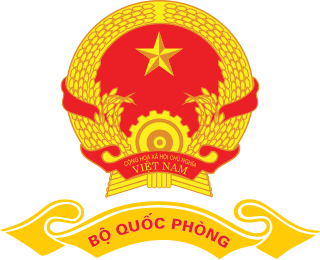
The Ministry of National Defence, alternatively the Ministry of Defence (MoD), fully the Ministry of Defence of the Socialist Republic of Vietnam, is the governmental ministry of the Socialist Republic of Vietnam that manages, coordinates and supervises military affairs, including all military units, paramilitary units, and similar agencies in the country. The major office of the Ministry of National Defence is located within the ancient Hanoi Citadel. The ministry is operated in compliance with the Constitution and Laws of the Socialist Republic of Vietnam, ideologically under the leadership of the Communist Party of Vietnam and the unified State management of the Vietnamese Government. It runs the People's Army Newspaper and the Military Broadcasting Center together with the Central Military Commission of the Communist Party of Vietnam. Besides press and media agencies, the Ministry of National Defence also owns and administers a number of enterprises, noticeably the Viettel Military Industry and Telecoms Group besides many core businesses of the Vietnamese defence industry.

Trần Anh Tông, personal name Trần Thuyên (陳烇), courtesy name Nhật Sủy (日煃) or Nhật Sáng (日㷃/日𤊞), was the fourth emperor of the Trần dynasty, reigning over Dai Viet from 1293 to 1314. After ceding the throne to his son Trần Minh Tông, Anh Tông held the title Retired Emperor for six years. As the first Trần emperor who ruled in total peace with respect to foreign affairs, Anh Tông was known for his successful reign of Đại Việt, which brought a long period of peace and prosperity over the country. He also had several military victories over the kingdoms of Champa and Lan Xang.
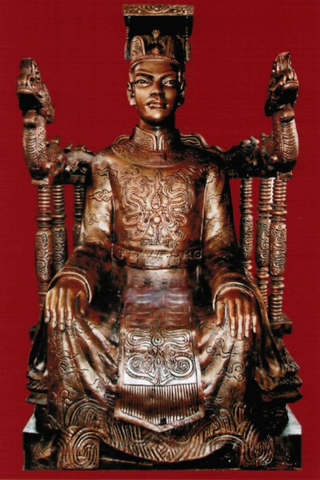
Trần Hiến Tông, given name Trần Vượng, was the sixth emperor of the Trần dynasty who reigned Đại Việt from 1329 to 1341. Enthroned by Minh Tông when he was only a ten-year-old boy, Hiến Tông ruled Đại Việt with the regent of the Retired Emperor Minh Tông during his thirteen years of reign. The Emperor died at the age of 23 and leaving no heir, he was succeeded by his younger brother Trần Hạo. The death of Hiến Tông and his father afterward marked the turning-point in history of Trần dynasty when the country began to fall into the trouble times.
Prince Chiêu Minh Trần Quang Khải (1241–1294) was the third son of Trần Thái Tông, first emperor of the Trần dynasty of Vietnam. Being the younger brother of the Emperor Trần Thánh Tông and holding the position of grand chancellor of the Trần dynasty for many years, Trần Quang Khải was one of the most important figures of the Trần family and the royal court during the reigns of emperors Thánh Tông and Nhân Tông. In the second war of resistance against the Mongol invasion, Trần Quang Khải and Trần Hưng Đạo were two key commanders of the Đại Việt army who helped the Emperor defeat the troops of Kublai Khan's son prince Toghan. Besides his military and administrative activities, Prince Chiêu Minh was also a famous poet and was credited as the creator of the dance of flowers. Today, Trần Quang Khải is still considered one of the most famous historical figures of the Trần dynasty and is worshiped in several temples in Vietnam.

Vukhuclepis lyhoaensis is an extinct, primitive antiarch placoderm. Specimens are of mostly complete thoracic armor from the Early Devonian Ly Hoa Formation in Vietnam. The armor is very similar to that of Yunnanolepis, but is distinguished by a unique pattern of raised ridges radiating from a point at the center of the dorsal shield of the thoracic armor. A similar, albeit more floral-looking pattern is seen in the Chinese Mizia. V. lyhaoensis' armor is further ornamented with small tubercles.

Võ Văn Thưởng is a Vietnamese politician who served as the 12th president of Vietnam from March 2023 to March 2024, being the youngest person to serve in this position since the country's reunification at the age of 52. His resignation after just over one year in office amidst the Communist Party's anti-corruption campaign made him the second shortest-serving president in Vietnamese history, after Tô Lâm.
References
- ↑ Janvier, P., Tông-Dzuy, T., Doàn Nhât, T., 1994. Devonian fishes from Viet Nam: new data form CentralViet Nam and their palaeobiogeographical significance. Proceedings of the International Symposium on Stratigraphic Correlation of Southeast Asia, Bangkok, pp. 69–74.
- ↑ Janvier, P., Tông-Dzuy, T., Phuong, T.H., Doàn Nhât, T., 1997. The Devonian vertebrates (Placodermi, Sarcopterygii) from Central Vietnam and their bearing on the Devonian palaeogeography of Southeast Asia. Journal of Asian Earth Sciences 15, 393–406.








